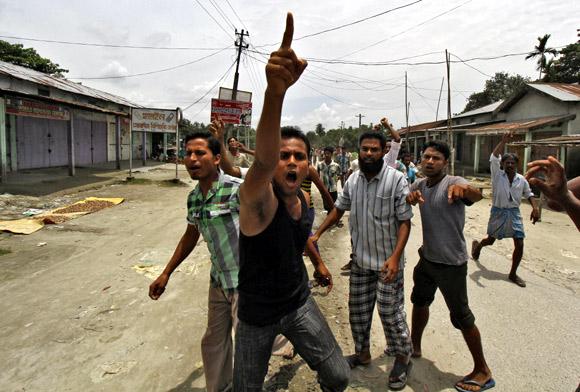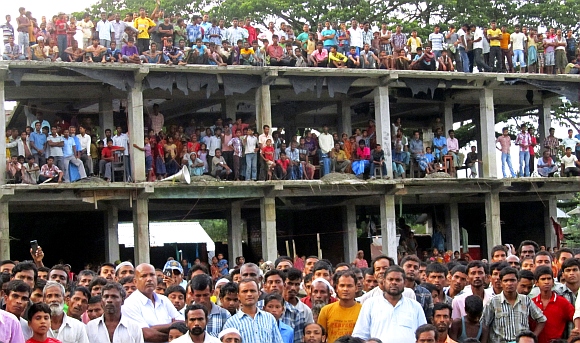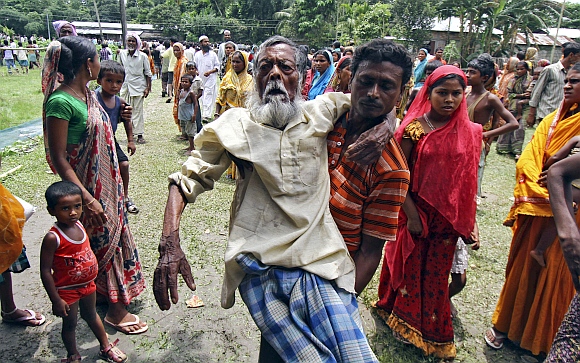
As forty-five people lost their lives and 200,000 people were rendered homeless in the week-long communal violence between the Bodo tribals and the Muslim immigrants, the Assam government in northeast India ummed and ahhed, says Bibhu Prasad Routray
Men, women and children from 500 villages filled in the 128 temporary relief camps and in all probability would stay there for months waiting for the paltry rationed food.
By all means, the sorry state of affairs could very have been very well prevented had a gargantuan administrative and governance paralysis, rooted in deep seated politics, not set in.
Trouble started on May 29 with the Muslim youth group, the All Bodoland Minority Students' Union, protesting against the removal of a signboard from a mosque, allegedly illegally built on a forest area.
The local Bodoland Territorial Council administration prevented the protesters from forcing shops and offices to close, which resulted in a fracas and injuries to some people. On July 6, two Muslim youths were killed by unidentified gunmen in Kokrajhar district.
Thirteen days later, on July 19, two more Muslim youths, leaders of the ABMSU, were killed in the same district. On July 20, four former Bodo Liberation Tigers cadres were killed by a Muslim mob. The incident sparked off a series of attacks and counter-attacks the same night and later, blew up into full-scale conflict.
Rioters indulged in both pre-planned as well as opportunistic violence- killing, burning and ransacking. Factors rooted in politics and demography provide explanations for the recent flare up.
...

Assam presents a case of intriguing ethnicity, with tribal groups asserting both peacefully as well as in violent ways, for rights over ever depleting resources. The erstwhile BLT waged a war demanding a separate Bodo homeland, alleging discrimination at the hands of the mainstream Assamese.
In 2003, the group settled for the BTC and converted itself into a political party, the Bodoland People's Front. For the state government, which had faced the division of the state when the BLT was at its capable best, the BTC was a far more agreeable solution.
The fact that the autonomous councils in the Assam, in spite of their constitutional sanctions, are failed instruments of effective administration didn't appear to matter.
The BTC experiment is skewed, to say the least. While it sought to protect the interests of the Bodos, even in areas where their numerical strength significantly lower than the non-Bodos, little attention was paid to secure the rights of other minority communities in the area.
Non-Bodos argue that political power at the hands of Bodos altered the dynamics on the ground. Bodos, on the other hand, allege that the immigration of Muslims, predominantly from neighbouring Bangladesh, has altered the demography.
In a scenario where land is scarce and resources are depleting fast, such acrimonious existence is sure shot recipe for disaster. Not surprisingly, the area has witnessed regular communal flare ups in the past years, each of them veering around the same issue and each resulting in the large number of deaths and displacements of thousands.
...

The last communal flare up in 2008 had resulted in the loss of 55 lives and displacement of 200,000 people.
Given the ethnic tinderbox the region is and its history of communal flare ups, the State government is expected to be extra sensitive and proactive in its reaction. However, amid killings and houses being burnt to ashes, Chief Minister Tarun Gogoi, who also doubles up as the home minister of the state, was busy repudiating the theory that immigrant Muslims are behind the riots.
A senior police officer in the affected region resigned as his repeated demand for forces in the initial days was not acceded to. For a state which already has a large contingent of central forces including the Army to fight the now largely subsided insurgency, the circumstances leading to the delay in deployment of forces in adequate strength to contain violence was surprising.
Such procrastination is rooted in the electoral support his government seeks among the Muslims -- both indigenous and the migrants from Bangladesh alike -- in the successive elections. During the 2008 riots, Gogoi had tried finding an escape route by blaming another insurgent group, National Democratic Front of Bodoland for the violence, to be repudiated by his own police chief.
This time, no such diversionary scope was available.
Gogoi found himself torn between supporting his vote bank and heeding to the demands of alliance politics. The BPF is a coalition partner with the Congress party in the state and has a minister in the government.
...

Thus, even as the chief minister refrained from endorsing the claim of the BPF Chief Hagrama Mohilary that the 'violence was being instigated by infiltrators from Bangladesh', he was constrained to go slow in responding swiftly to the flare up, lest this not be seen as anti-Muslim and pro-Bodo measure.
Further, the nature of ceasefire agreements the state has entered into to quell ethnic insurgencies in the past years, has created an enabling environment for the rioters to be highly efficient killers.
Neither the ceasefires which confines the militants to designated camps, nor the peace deals have given sufficient attention to the aspect of gaining control over the weapons in possession of the insurgents.
As a result, an environment of peace coexists with a large number of former militants with accesses to stocks of firearms, stashed away for both personal use and also on occasions like this. The erstwhile Bodo militants, according to an estimate, have at least 1,200 firearms, away from the supervision of the authorities.
By July 27, only sporadic violence was being reported from the area. Authorities claimed restoration of order and return of normalcy.
However, the fact remains that while the current phase of violence might have been pacified, unless the government takes steps to permanently address the deep schism between communities, such flare ups would remain a perennial part of Assam's existence.
The author, a Singapore-based security analyst, served as a deputy director in the National Security Council Secretariat, currently is a senior analyst with the Wikistrat. He can be contacted at bibhuroutray@gmail.com and on Twitter @BibhuRoutray
...